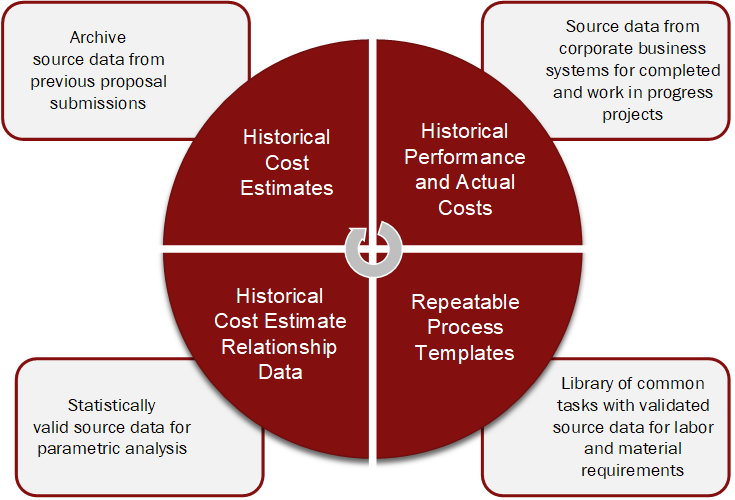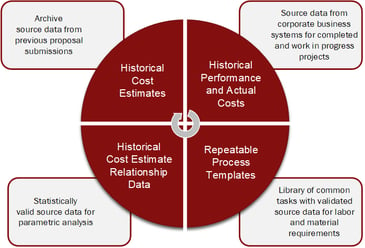What do we mean by “closed loop cost estimating?” It is a defined process to routinely collect and organize relevant source data for proposal teams that they can use to substantiate the basis for their cost estimates. The goal is to create a searchable database of reliable source data so they can produce data driven cost estimates easier and faster.
It is a virtuous cycle because you get closer to the truth with each proposal. As more relevant source data is added over time, the quality of the cost estimates increase because the estimates more accurately reflect likely actual costs. With realistic cost estimates, it is easier to predict a likely profit margin for the awarded contract. You have confidence you can deliver the product or service to the customer as planned, the customer is happy with your services, and your company makes money.
The image below illustrates common components useful for building a searchable database of reliable source data for proposal teams to use.

Historical Performance and Actual Costs
This is the best source of reliable source data for labor hours, material costs, and other costs expended to perform work on completed or work in progress projects. For proposal teams to be able to use this data, they need:
- Access to the historical performance data. This is often a challenge to capture the difference between an original plan to complete work and what actually occurred to be able to determine whether the original plan was realistic. The data may be scattered across different schedule or cost management tools or one-off solutions project control teams may use including Microsoft Excel. The scope of the data is such that it isn’t easy to routinely collect the planned versus actual duration of a task, resources assigned to the task and what resources actually performed the work, and related time phased cost details. Were planned durations reasonable or did it take more time to do the work? Was the number of labor hours expended greater than or less than planned? Was the cost of materials or quantity higher or lower than expected? Was the difference significant? This can help pinpoint factors to consider when proposal teams create their proposal schedules and time phased cost estimate.
- Access to the historical actual cost source data. Sometimes this is a challenge because proposal team members may not be authorized to access the data in corporate business systems. Or, how the data is organized makes it difficult to find relevant source data that correlates to the likely tasks required to perform the proposed scope of work. Corporate business systems such as accounting, material management, or timekeeping are designed for other purposes.
- A framework to identify tasks that are similar to the likely tasks required to perform the work as described in the proposal’s statement of work. This also applies to the labor skill sets or categories of resources such as engineering material or manufacturing material.
Repeatable Process Templates
The purpose of these templates is to capture a set of common tasks that are often performed complete with the labor, material, and other non-labor resource requirements such as travel or use of specialized facilities. This includes the typical duration for the tasks, skill mix, labor hours for the different types of resources, and list of materials. The template content is based on an analysis of historical project performance and actual costs to complete these tasks. Including documentation about the tasks and resources in the templates helps proposal teams determine whether a specific template is applicable for their needs.
These templates are particularly useful for organizing tasks with labor resources and related bill of material quantities required to build an assembly, service or refurbish a piece of equipment, or pave a road. The proposal teams can modify the applicable factor that is the productivity driver for these tasks for their cost estimate such as the number of assemblies or pieces of equipment, size of the work crew, or square footage.
Building a library of process templates over time helps to establish a consistent basis for proposal teams to produce data driven cost estimates. Once again, the historical performance and actual costs provide the reliable source data for the proposal teams.
Historical Cost Estimate Relationship Data
Building a database of statistically valid cost estimating relationship (CER) data is dependent on your business environment and may or may not apply. Your proposal teams may or may not use parametric estimating techniques. Parametric estimating also requires reliable historical data to build a database of relevant cost estimate relationship data and identify the independent variable that drives the cost estimate. Additional analysis is often performed to eliminate outliers and verify other factors that could impact the validity of the data.
Historical Cost Estimates
It also helps proposal teams to be able to access cost estimates developed in the past. There is often useful source data and basis of estimate rationale they can analyze for potential use in their proposal. Was the basis of estimate in a previous proposal for an awarded contract spot on? Or, was it way off? What assumptions or other factors made a difference? Can those factors be isolated? The proposal team can further verify that with the ability to compare the basis of estimate to actual costs incurred to perform the work on a similar project.
Putting All the Pieces Together
This where ProjStream’s end-to-end solution of proposal writing, cost estimating, and project cost management software can help you create a common database for closed loop cost estimating. BOEMax proposal software and MaxTeam cost management software share a common database for proposal teams to create their cost estimates, document their basis of estimates, and manage the proposal development process. At contract award, the project control teams can use the source project from BOEMax to create their budget baseline and manage the execution phase of the project including approved changes to the baseline. As the work is completed, the project’s performance and actual costs along with the estimate to complete the work are captured in MaxTeam. The project control teams can also track the project’s cash flow and revenue projections in these software tools.
BOEMax offers a shared database and robust search function that are powerful tools for proposal teams. In the basis of estimate software, they can search other proposal projects, work in progress projects, or completed projects for similar elements of work, tasks or work packages, resource assignments, or user defined attributes to help them create their cost estimate and document their basis of estimate rationale.
The right bidding and cost control software tools are only part of the equation. It also helps to establish a foundation of standard methodologies to leverage that database. For example, consider:
- Creating templates that help to structure the data so it is easier to search and locate relevant similar work effort. The process library templates in BOEMax is one example. Foundation project templates with a base set of WBS elements built out with work packages and resource assignment details is another.
- Establishing standard terms or descriptions for common tasks so proposals teams can easily search and compare data from different projects to verify assumptions or actual performance.
- Adding user defined attributes to WBS elements or work packages that help to organize tasks into groups or categories. This also makes it easier to search and locate similar work effort.
We discuss these methodologies in more depth in the blog Enabling a Closed Loop Cost Estimating Searchable Database.
Interested in learning more about how you can use closed loop cost estimating to improve as well as streamline your proposal process? Give us a call today to schedule a software demo.


